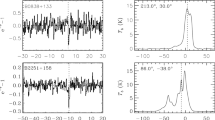Abstract
We report multi-frequency radio continuum and hydrogen radio recombination line observations of HII regions near l = 24.8°, b = 0.1° using the Giant Metrewave Radio Telescope (GMRT) at 1.28 GHz (n = 172), 0.61 GHz (n = 220) and the Very Large Array (VLA) at 1.42 GHz (n = 166). The region consists of a large number of resolved HII regions and a few compact HII regions as seen in our continuum maps, many of which have associated infrared (IR) point sources. The largest HII region at l = 24.83° and b = 0.1° is a few arcmins in size and has a shell-type morphology. It is a massive HII region enclosing ∼550 M⊙ with a linear size of 7 pc and an rms electron density of ∼110 cm−3 at a kinematic distance of 6 kpc. The required ionization can be provided by a single star of spectral type O5.5.
We also report detection of hydrogen recombination lines from the HII region at l = 24.83° and b = 0.1° at all observed frequencies near V lsr = 100 km s−1. We model the observed integrated line flux density as arising in the diffuse HII region and find that the best fitting model has an electron density comparable to that derived from the continuum. We also report detection of hydrogen recombination lines from two other HII regions in the field.
Similar content being viewed by others
References
Anantharamaiah, K. R. 1985, J. Astrophys. Astr., 6, 177.
Ananthakrishnan, S., Rao, A. P. 2002, In: Multicolour Universe (eds) Manchanda, R. K., Paul, B., p. 233.
Codella, C., Felli, M., Natale, V. 1994, Astron. Astrophys., 284, 233.
Conti, P., Crowther, P. A. 2004, Mon. Not. R. Astron. Soc., 355, 899.
Downes, D., Wilson, T. L., Bieging, J., Wink, J. 1980, Astron. Astrophys. Suppl., 40, 379.
Dravskikh, Z. V., Dravskikh, A. F. 1964, Astron. Tsirk, 158, 2.
Furuya, R. S., Cesaroni, R., Codella, C. et al. 2002, Astron. Astrophys., 390, L1.
Haslam, C. G. T., Salter, C. J., Stoffel, H., Wilson, W. E. 1982, Astron. Astrophys. Suppl., 47, 1.
Heiles, C., Reach, W. T., Koo, B.-C. 1996, Astrophys. J., 466, 191.
Lockman, F. J. 1989, Astrophys. J., 71, 469.
Lockman, F. J., Pisano, D. J., Howard G. J. 1996, Astrophys. J., 472, 173.
Mezger, P. G., Henderson, A. P. 1967, Astrophys. J., 147, 471.
Palmer, P., Zuckermann, B., Penfield, H., Lilley, A. F., Mezger, P. G. 1967, Astron. J., 72, 821.
Panagia, N. 1973, Astron. J., 78, 929.
Payne, H. E., Anantharamaiah, K. R., Erickson, W. C. 1994, Astrophys. J., 430, 690.
Roshi, D. A., Anantharamaiah, K. R. 2001, Astrophys. J., 557, 226.
Salem, M., Brocklehurst, M. 1979, Astrophys. J. Suppl., 39, 633.
Shaver, P. A. 1975, Pramana, 5, 1.
Sorochenko, R. L., Borozich, E. V. 1964, Rep. Sov. Acad. Sci., 162, 603.
Swarup, G., Ananthakrishnan, S., Kapahi, V. K. et al. 1991, Curr. Sci., 60, 95.
Walmsley, C. M., Watson, W. D. 1982, Astrophys. J., 260, 317.
Author information
Authors and Affiliations
Rights and permissions
About this article
Cite this article
Kantharia, N.G., Goss, W.M., Roshi, D.A. et al. GMRT and VLA observations at 49 cm and 20 cm of the HII region near l = 24.8°, b = 0.1°. J Astrophys Astron 28, 41–53 (2007). https://doi.org/10.1007/s12036-007-0005-7
Received:
Accepted:
Published:
Issue Date:
DOI: https://doi.org/10.1007/s12036-007-0005-7




